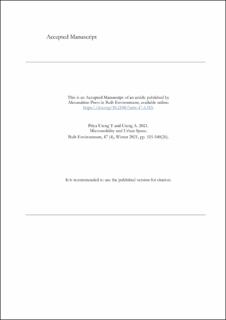| dc.contributor.author | Uteng, Tanu Priya | |
| dc.contributor.author | Uteng, Andre | |
| dc.coverage.spatial | Norway | en_US |
| dc.date.accessioned | 2022-06-16T20:29:39Z | |
| dc.date.available | 2022-06-16T20:29:39Z | |
| dc.date.created | 2021-12-21T17:30:31Z | |
| dc.date.issued | 2021-12-01 | |
| dc.identifier.citation | Built Environment. 2021, 47 (4), 515-540. | en_US |
| dc.identifier.issn | 0263-7960 | |
| dc.identifier.uri | https://hdl.handle.net/11250/2999121 | |
| dc.description.abstract | The transport sector aims to address climate change by reducing emissions, and a key to achieving this goal is to increase uptake of sustainable modes such as walking, cycling, and public transport. Therefore, it is important to determine ways to achieve this goal and to build a portfolio of feasible reduction strategies. This study is based in Norway where the government has a clear policy objective to reduce growth in urban car traffic and assimilate future sustainable transport modes. Cycling has therefore gained importance in both policy discussions and programme implementation through providing dedicated infrastructure to increase its modal share. Ways to increase cycling can be plotted at both macro- and microlevels. At the micro-level, road design and improved conditions for cyclists can lead to an increase in cycling. At the macro-level, land-use planning can be one of the tools to promote cycling. We analyse the issue at a macro-level based on an Integrated Methodology for Land Use prognosis within Transportation Models (INMAP) which estimates the mutual eff ects of land-use plans and increased accessibility by e-bike. We assess the extent to which future growth areas, as earmarked by the strategic master plans of the cities of Oslo and Trondheim, coincide with the areas that have a high job accessibility by bicycle and e-bike. Analyses reveal that on the introduction of e-bikes in Oslo, accessibility to jobs in the city centre increases from 20,000–24,000 to over 28,000 jobs. For Trondheim, in terms of spatial expansion of accessibility for jobs, there is an extension of the catchment area from 6 km2 to 18 km2. Based on the findings, this study strongly recommends integrating the impact of e-bikes with land-use planning processes and decisions. Through active land-use management, municipalities and regional development authorities can take informed decisions to steer urban mobility in a more sustainable direction. | en_US |
| dc.language.iso | eng | en_US |
| dc.publisher | Alexandrine Press | en_US |
| dc.rights | Navngivelse 4.0 Internasjonal | * |
| dc.rights.uri | http://creativecommons.org/licenses/by/4.0/deed.no | * |
| dc.title | Accessibility Mapping through Linking Land-Use Development Potentials and Planning for Cycling | en_US |
| dc.type | Peer reviewed | en_US |
| dc.type | Journal article | en_US |
| dc.rights.holder | © 2021 Ingenta. Article copyright remains with the publisher, society or author(s) as specified within the article. | en_US |
| dc.description.version | acceptedVersion | en_US |
| cristin.ispublished | true | |
| cristin.fulltext | postprint | |
| cristin.qualitycode | 1 | |
| dc.identifier.doi | 10.2148/benv.47.4.515 | |
| dc.identifier.cristin | 1971221 | |
| dc.source.journal | Built Environment | en_US |
| dc.source.volume | 47 | en_US |
| dc.source.issue | 4 | en_US |
| dc.source.pagenumber | 515-540 | en_US |
| dc.relation.project | Norges forskningsråd: 255628 | en_US |
| dc.relation.project | Norges forskningsråd: 267877 | en_US |

